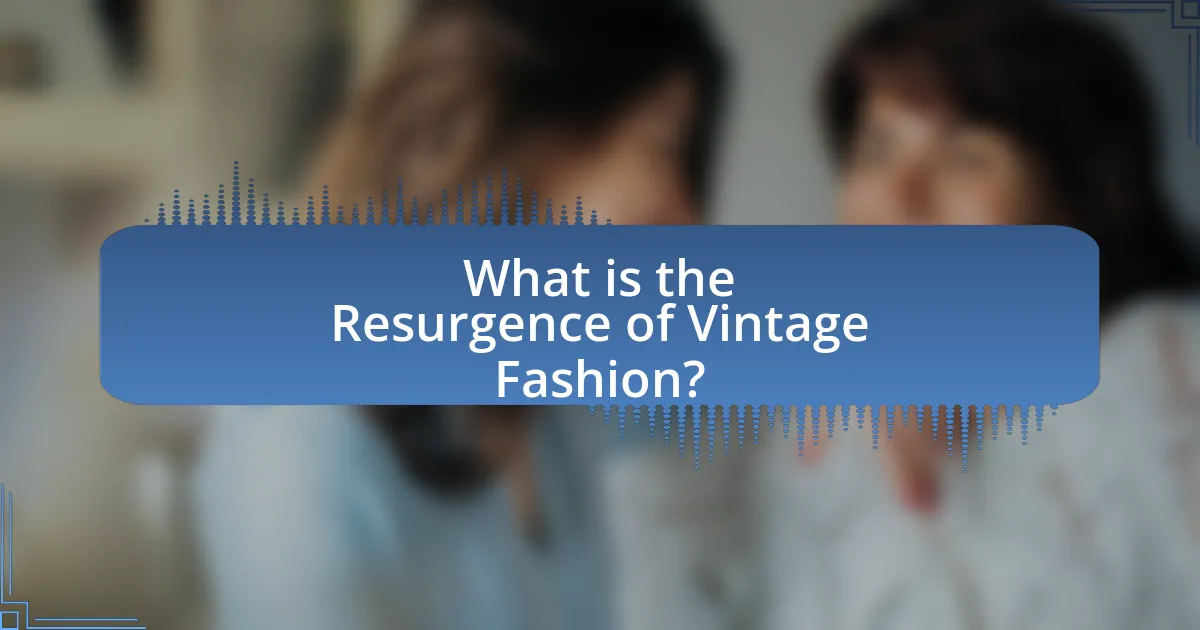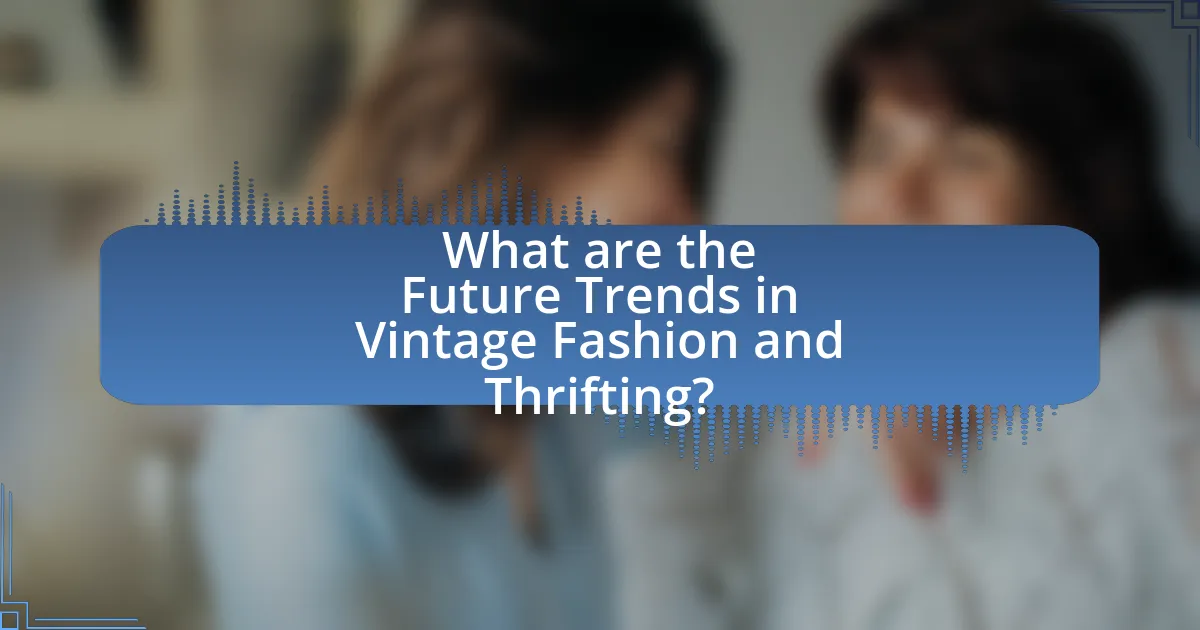The article examines the resurgence of vintage fashion, highlighting its growing popularity driven by sustainability concerns, individuality, and social media influence. It discusses the projected growth of the secondhand market, expected to reach $64 billion by 2024, and explores cultural factors that contribute to this trend, including nostalgia and environmental consciousness. The piece also delves into the role of thrifting in promoting sustainable fashion practices, the impact of social media on consumer behavior, and the challenges and strategies associated with successful thrifting. Additionally, it outlines future trends in vintage fashion and thrifting, emphasizing the importance of technology and best practices for shoppers.

What is the Resurgence of Vintage Fashion?
The resurgence of vintage fashion refers to the renewed interest and popularity in clothing styles from previous decades, particularly from the 1920s to the 1990s. This trend is driven by a combination of factors including sustainability concerns, the desire for unique and one-of-a-kind pieces, and the influence of social media platforms showcasing vintage aesthetics. According to a 2021 report by ThredUp, the secondhand market is projected to reach $64 billion by 2024, indicating a significant shift towards vintage and thrifted clothing. This resurgence reflects a broader cultural movement valuing individuality and environmental consciousness in fashion choices.
Why is vintage fashion becoming popular again?
Vintage fashion is becoming popular again due to a growing consumer interest in sustainability and individuality. As awareness of fast fashion’s environmental impact increases, many consumers are seeking unique, second-hand clothing options that reduce waste. According to a 2021 report by ThredUp, the second-hand market is projected to reach $64 billion by 2024, indicating a significant shift in consumer behavior towards vintage and thrifted items. This trend is further fueled by social media platforms, where influencers showcase vintage styles, making them more accessible and desirable to a wider audience.
What cultural factors are driving this resurgence?
The resurgence of vintage fashion is primarily driven by a growing cultural emphasis on sustainability and individuality. Consumers increasingly prioritize eco-friendly practices, leading to a rise in thrifting as a means to reduce waste and promote circular fashion. According to a 2021 report by ThredUp, the secondhand market is projected to reach $64 billion by 2024, reflecting a significant shift in consumer behavior towards sustainable choices. Additionally, the desire for unique, one-of-a-kind pieces fosters a sense of personal expression, as individuals seek to differentiate themselves from mass-produced fashion trends. This combination of sustainability and individuality is reshaping the fashion landscape, making vintage and thrifted items more desirable.
How does nostalgia influence consumer behavior in fashion?
Nostalgia significantly influences consumer behavior in fashion by driving demand for vintage and retro styles that evoke fond memories. This emotional connection to past eras encourages consumers to seek out clothing that reminds them of their youth or cultural milestones, leading to increased sales in thrift stores and vintage shops. Research indicates that nostalgia can enhance brand attachment and consumer loyalty, as seen in a study published in the Journal of Consumer Research, which found that nostalgic feelings can increase willingness to pay for products associated with positive memories. Thus, nostalgia not only shapes individual purchasing decisions but also impacts broader fashion trends, making vintage fashion a prominent choice among consumers today.
What role does sustainability play in the vintage fashion trend?
Sustainability is a fundamental aspect of the vintage fashion trend, as it promotes the reuse of clothing and reduces waste in the fashion industry. By choosing vintage items, consumers contribute to a circular economy that minimizes the environmental impact associated with the production of new garments. According to a 2021 report by the Ellen MacArthur Foundation, the fashion industry is responsible for 10% of global carbon emissions, highlighting the importance of sustainable practices. Vintage fashion not only extends the lifecycle of clothing but also encourages a shift away from fast fashion, which is often linked to unsustainable practices and overconsumption.
How does thrifting contribute to sustainable fashion practices?
Thrifting contributes to sustainable fashion practices by promoting the reuse of clothing, which reduces waste and the demand for new garment production. By purchasing second-hand items, consumers extend the lifecycle of clothing, thereby minimizing the environmental impact associated with manufacturing, such as water usage and carbon emissions. According to a report by the Ellen MacArthur Foundation, extending the life of clothes by just nine months can reduce carbon, water, and waste footprints by around 20-30%. This demonstrates that thrifting not only supports individual sustainability efforts but also plays a significant role in addressing the broader environmental challenges posed by the fast fashion industry.
What are the environmental benefits of choosing vintage over fast fashion?
Choosing vintage over fast fashion significantly reduces environmental impact by minimizing waste and resource consumption. Vintage clothing extends the lifecycle of garments, preventing them from ending up in landfills; the fashion industry is responsible for 92 million tons of waste annually, according to the United Nations. Additionally, vintage shopping reduces the demand for new clothing production, which is resource-intensive, consuming approximately 2,700 liters of water to produce a single cotton t-shirt. By opting for vintage, consumers contribute to a more sustainable fashion ecosystem, decreasing pollution and conserving natural resources.
How has social media impacted the popularity of vintage fashion?
Social media has significantly increased the popularity of vintage fashion by providing a platform for users to share and discover unique styles. Platforms like Instagram and TikTok allow influencers and everyday users to showcase vintage outfits, creating trends that resonate with a wider audience. For instance, hashtags such as #vintagefashion and #thrifting have garnered millions of posts, demonstrating a collective interest in retro styles. This visibility encourages consumers to seek out vintage pieces, leading to a resurgence in thrift shopping and vintage boutiques. Additionally, the viral nature of social media content accelerates the spread of vintage fashion trends, making them more accessible and appealing to younger generations.
What platforms are most influential in promoting vintage styles?
Social media platforms, particularly Instagram and TikTok, are the most influential in promoting vintage styles. Instagram’s visual-centric approach allows users to showcase vintage outfits through curated feeds and hashtags, such as #vintagefashion, which has millions of posts. TikTok’s short-form video format enables users to create engaging content that highlights vintage finds and styling tips, driving trends rapidly among younger audiences. Both platforms leverage user-generated content and influencer partnerships to amplify the visibility of vintage fashion, making them key players in the resurgence of this style.
How do influencers shape consumer perceptions of vintage fashion?
Influencers shape consumer perceptions of vintage fashion by curating and showcasing unique pieces that highlight the aesthetic and sustainability aspects of vintage clothing. Their social media platforms serve as visual storytelling tools, where influencers often share personal narratives and styling tips that resonate with their followers, making vintage fashion more relatable and desirable. For instance, a study by the Journal of Fashion Marketing and Management found that influencers significantly impact consumer attitudes towards sustainable fashion choices, with 70% of respondents indicating that influencer endorsements made them more likely to purchase vintage items. This demonstrates that influencers not only promote vintage fashion but also enhance its appeal through authenticity and community engagement.

What are the Key Aspects of Thrifting?
The key aspects of thrifting include sustainability, cost-effectiveness, and unique fashion finds. Sustainability is emphasized as thrifting reduces waste by giving pre-owned items a second life, thereby minimizing the environmental impact of fast fashion. Cost-effectiveness is evident as thrift stores offer significantly lower prices compared to retail, making fashion accessible to a wider audience. Unique fashion finds are a hallmark of thrifting, as shoppers often discover one-of-a-kind pieces that reflect personal style and vintage trends, contributing to the resurgence of vintage fashion.
How does thrifting differ from traditional shopping?
Thrifting differs from traditional shopping primarily in its sourcing and pricing. Thrifting involves purchasing second-hand items from thrift stores, consignment shops, or online platforms, often at significantly lower prices compared to new retail items. Traditional shopping typically involves buying new products from established retailers at full price. According to a 2021 report by ThredUp, the second-hand market is projected to reach $64 billion by 2024, highlighting the growing popularity of thrifting as a cost-effective and sustainable alternative to traditional shopping.
What types of items can be found in thrift stores?
Thrift stores typically offer a wide variety of items, including clothing, furniture, home decor, books, and electronics. Clothing often features vintage and second-hand apparel, which appeals to consumers seeking unique fashion pieces. Furniture can range from retro styles to contemporary designs, providing affordable options for home furnishing. Home decor items may include artwork, kitchenware, and decorative accessories, often reflecting diverse styles and eras. Books and electronics, such as used gadgets and appliances, are also commonly found, catering to budget-conscious shoppers. The diversity of these items contributes to the growing popularity of thrift stores as a sustainable shopping alternative.
How does the pricing of thrifted items compare to retail prices?
Thrifted items are typically priced significantly lower than retail prices, often ranging from 30% to 90% less than new items. This price disparity is due to factors such as the second-hand nature of thrifted goods, lower overhead costs for thrift stores, and the unique, often vintage appeal of these items that attract budget-conscious consumers. For example, a brand-name dress that retails for $100 may be found at a thrift store for $10 to $30, making thrifting an economical choice for fashion enthusiasts.
What skills are necessary for successful thrifting?
Successful thrifting requires skills such as keen observation, negotiation, and knowledge of fashion trends. Keen observation allows individuals to identify valuable items among a vast selection, while negotiation skills help in securing better prices. Additionally, understanding current fashion trends enables thrifters to discern which items are likely to be in demand, enhancing their resale potential. These skills are essential for maximizing the benefits of thrifting, as they directly influence the ability to find unique pieces and achieve cost savings.
How can shoppers identify quality vintage pieces?
Shoppers can identify quality vintage pieces by examining the craftsmanship, materials, and brand reputation. High-quality vintage items often feature durable fabrics, intricate stitching, and unique design elements that reflect the era they come from. For instance, garments made from natural fibers like wool, silk, or cotton are typically more desirable than those made from synthetic materials. Additionally, well-known brands from the past, such as Chanel or Levi’s, often signify higher quality due to their established reputation for excellence. Shoppers should also look for labels that indicate the item’s origin and age, as authentic vintage pieces usually have tags that reflect their historical context.
What strategies can enhance the thrifting experience?
To enhance the thrifting experience, shoppers should adopt strategies such as setting a budget, visiting stores during off-peak hours, and being open-minded about potential finds. Setting a budget helps prevent overspending, while shopping during quieter times allows for a more relaxed experience and better access to unique items. Additionally, maintaining an open mind encourages exploration of various styles and items, increasing the likelihood of discovering hidden gems. Research indicates that thrifting can lead to more sustainable fashion choices, as it promotes recycling and reduces waste, aligning with the growing trend of eco-conscious consumerism.
What challenges do thrift shoppers face?
Thrift shoppers face several challenges, including limited inventory, sizing inconsistencies, and the time-consuming nature of searching for items. Limited inventory can result in fewer options, making it difficult for shoppers to find specific items or sizes. Sizing inconsistencies arise because thrifted clothing often comes from various brands and eras, leading to a lack of standardization in fit. Additionally, the process of sifting through racks and bins to find desirable pieces can be time-consuming and requires patience, which may deter some potential shoppers.
How can shoppers overcome common obstacles in thrift stores?
Shoppers can overcome common obstacles in thrift stores by employing strategic planning and patience. First, they should allocate sufficient time for browsing, as thrift stores often require more effort to find quality items compared to traditional retail. Additionally, shoppers can enhance their experience by visiting stores during off-peak hours, which allows for a more relaxed environment and better access to merchandise.
Furthermore, creating a list of desired items or specific styles can help focus the search and reduce overwhelm. Shoppers should also be prepared to dig through racks and shelves, as valuable finds are often hidden among less desirable items. Research indicates that thrift shopping can yield significant savings, with some items priced up to 90% lower than their retail counterparts, making the effort worthwhile. By adopting these strategies, shoppers can effectively navigate the challenges of thrift stores and enjoy the benefits of vintage fashion.
What are the potential downsides of thrifting?
The potential downsides of thrifting include limited availability of specific items, potential quality issues, and the time-consuming nature of searching through large quantities of goods. Limited availability arises because thrift stores often have a constantly changing inventory, making it difficult to find particular sizes or styles. Quality issues can occur as second-hand items may have wear and tear, stains, or damage that is not immediately visible. Additionally, the process of sifting through racks and bins can be time-consuming, requiring patience and effort to find desirable pieces.

What are the Future Trends in Vintage Fashion and Thrifting?
Future trends in vintage fashion and thrifting indicate a significant shift towards sustainability and personalization. As consumers increasingly prioritize eco-friendly practices, the demand for second-hand clothing is expected to rise, with the global thrift market projected to reach $64 billion by 2024. Additionally, the integration of technology, such as online resale platforms and augmented reality, will enhance the shopping experience, allowing consumers to find unique pieces that reflect their individual style. This trend is further supported by the growing awareness of the environmental impact of fast fashion, driving a cultural shift towards valuing vintage items for their uniqueness and sustainability.
How is the vintage fashion market expected to evolve?
The vintage fashion market is expected to evolve significantly due to increasing consumer interest in sustainability and unique style. As more individuals prioritize eco-friendly practices, the demand for second-hand clothing is projected to rise, with the global second-hand apparel market expected to reach $64 billion by 2024, according to ThredUp’s 2021 Resale Report. This shift is driven by younger generations, particularly Millennials and Gen Z, who favor thrift shopping for its affordability and distinctiveness. Additionally, the integration of technology in the shopping experience, such as online resale platforms and social media marketing, is likely to enhance accessibility and visibility of vintage items, further propelling market growth.
What emerging styles are gaining traction in vintage fashion?
Emerging styles gaining traction in vintage fashion include Y2K aesthetics, 90s grunge, and 70s bohemian influences. The Y2K aesthetic, characterized by bright colors, crop tops, and low-rise jeans, has seen a resurgence among younger consumers, driven by social media platforms like TikTok. The 90s grunge style, featuring oversized flannel shirts, combat boots, and distressed denim, appeals to those seeking a nostalgic yet edgy look. Additionally, the 70s bohemian style, marked by flowing fabrics, earthy tones, and vintage prints, is becoming popular as consumers embrace a more relaxed and free-spirited fashion approach. These trends reflect a broader cultural shift towards sustainability and individuality in fashion choices.
How might technology influence the future of thrifting?
Technology will significantly influence the future of thrifting by enhancing online platforms for buying and selling second-hand goods. The rise of mobile applications and websites dedicated to thrift shopping, such as Depop and Poshmark, allows users to easily access a wider range of vintage items, increasing market reach and convenience. Additionally, advancements in artificial intelligence and machine learning can improve inventory management and personalized shopping experiences, making it easier for consumers to find items that match their preferences. According to a report by ThredUp, the second-hand market is projected to reach $64 billion by 2024, driven in part by these technological innovations that streamline the thrifting process and attract a younger, tech-savvy demographic.
What are the best practices for thrifting in the future?
The best practices for thrifting in the future include researching local thrift stores, utilizing online platforms, and prioritizing sustainability. Researching local thrift stores allows shoppers to identify unique items and understand pricing trends, enhancing the thrifting experience. Utilizing online platforms, such as Poshmark and Depop, expands access to a wider range of vintage items, catering to diverse styles and preferences. Prioritizing sustainability aligns with the growing consumer demand for eco-friendly practices, as thrifting reduces waste and promotes circular fashion. According to a 2021 report by ThredUp, the secondhand market is projected to reach $64 billion by 2024, highlighting the increasing popularity and importance of thrifting in future fashion trends.
How can shoppers stay ahead of trends in vintage fashion?
Shoppers can stay ahead of trends in vintage fashion by actively following fashion influencers and vintage enthusiasts on social media platforms. Engaging with these sources provides insights into emerging styles and popular items, as influencers often showcase unique finds and highlight current trends. Additionally, attending vintage fairs and markets allows shoppers to discover rare pieces and connect with other fashion-forward individuals, further enhancing their understanding of what is trending. Research indicates that social media has significantly influenced consumer behavior, with 54% of shoppers using platforms like Instagram for fashion inspiration, making it a vital tool for staying updated in the vintage fashion scene.
What tips can enhance the thrifting experience for new shoppers?
To enhance the thrifting experience for new shoppers, it is essential to approach thrifting with an open mind and a clear strategy. New shoppers should research local thrift stores and their specific offerings, as different stores may specialize in various items, such as clothing, furniture, or collectibles. Additionally, setting a budget before shopping can help manage spending and encourage thoughtful purchases.
New shoppers should also allocate sufficient time for browsing, as finding unique items often requires patience and exploration. Bringing a friend can make the experience more enjoyable and provide a second opinion on potential purchases. Lastly, understanding the importance of inspecting items for quality and potential repairs can lead to better finds and more satisfying purchases. These strategies are supported by the growing popularity of thrifting, which has seen a 20% increase in participation among consumers in recent years, highlighting the value and enjoyment of the thrifting experience.


